Paper Menu >>
Journal Menu >>
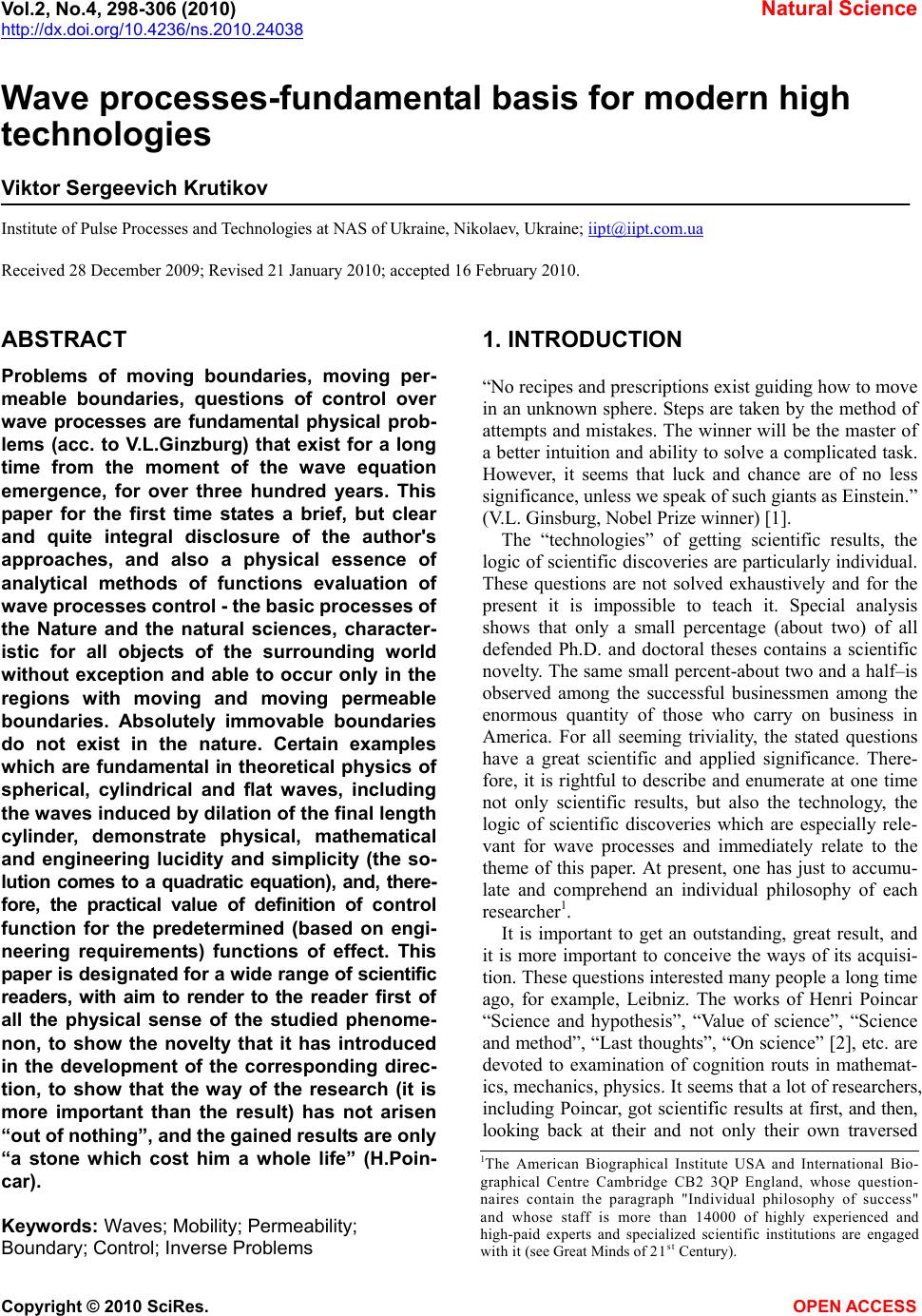 Vol.2, No.4, 298-306 (2010) Natural Science http://dx.doi.org/10.4236/ns.2010.24038 Copyright © 2010 SciRes. OPEN ACCESS Wave processes-fundamental basis for modern high technologies Viktor Sergeevich Krutikov Institute of Pulse Processes and Technologies at NAS of Ukraine, Nikolaev, Ukraine; iipt@iipt.com.ua Received 28 December 2009; Revised 21 January 2010; accepted 16 February 2010. ABSTRACT Problems of moving boundaries, moving per- meable boundaries, questions of control over wave processes are fundamental physical prob- lems (acc. to V.L.Ginzburg) that exist for a long time from the moment of the wave equation emergence, for over three hundred years. This paper for the first time states a brief, but clear and quite integral disclosure of the author's approaches, and also a physical essence of analytical methods of functions evaluation of wave processes control - the basic processes of the Nature and the natural sciences, character- istic for all objects of the surrounding world without exception and able to occur only in the regions with moving and moving permeable boundaries. Absolutely immovable boundaries do not exist in the nature. Certain examples which are fundamental in theoretical physics of spherical, cylindrical and flat waves, including the waves induced by dilation of the final length cylinder, demonstrate physical, mathematical and engineering lucidity and simplicity (the so- lution comes to a quadratic equation), and, there- fore, the practical value of definition of control function for the predetermined (based on engi- neering requirements) functions of effect. This paper is designated for a wide range of scientific readers, with aim to render to the reader first of all the physical sense of the studied phenome- non, to show the novelty that it has introduced in the development of the corresponding direc- tion, to show that the way of the research (it is more important than the result) has not arisen “out of nothing”, and the gained results are only “a stone which cost him a whole life” (H.Poin- car). Keywords: Waves; Mobility; Permeability; Boundary; Control; Inverse Problems 1. INTRODUCTION “No recipes and prescriptions exist guiding how to move in an unknown sphere. Steps are taken by the method of attempts and mistakes. The winner will be the master of a better intuition and ability to solve a complicated task. However, it seems that luck and chance are of no less significance, unless we speak of such giants as Einstein.” (V.L. Ginsburg, Nobel Prize winner) [1]. The “technologies” of getting scientific results, the logic of scientific discoveries are particularly individual. These questions are not solved exhaustively and for the present it is impossible to teach it. Special analysis shows that only a small percentage (about two) of all defended Ph.D. and doctoral theses contains a scientific novelty. The same small percent-about two and a half–is observed among the successful businessmen among the enormous quantity of those who carry on business in America. For all seeming triviality, the stated questions have a great scientific and applied significance. There- fore, it is rightful to describe and enumerate at one time not only scientific results, but also the technology, the logic of scientific discoveries which are especially rele- vant for wave processes and immediately relate to the theme of this paper. At present, one has just to accumu- late and comprehend an individual philosophy of each researcher1. It is important to get an outstanding, great result, and it is more important to conceive the ways of its acquisi- tion. These questions interested many people a long time ago, for example, Leibniz. The works of Henri Poincar “Science and hypothesis”, “Value of science”, “Science and method”, “Last thoughts”, “On science” [2], etc. are devoted to examination of cognition routs in mathemat- ics, mechanics, physics. It seems that a lot of researchers, including Poincar, got scientific results at first, and then, looking back at their and not only their own traversed 1The American Biographical Institute USA and International Bio- graphical Centre Cambridge CB2 3QP England, whose question- naires contain the paragraph "Individual philosophy of success" and whose staff is more than 14000 of highly experienced and high-paid experts and specialized scientific institutions are engaged with it ( see Great Minds of 21st Centur y) . 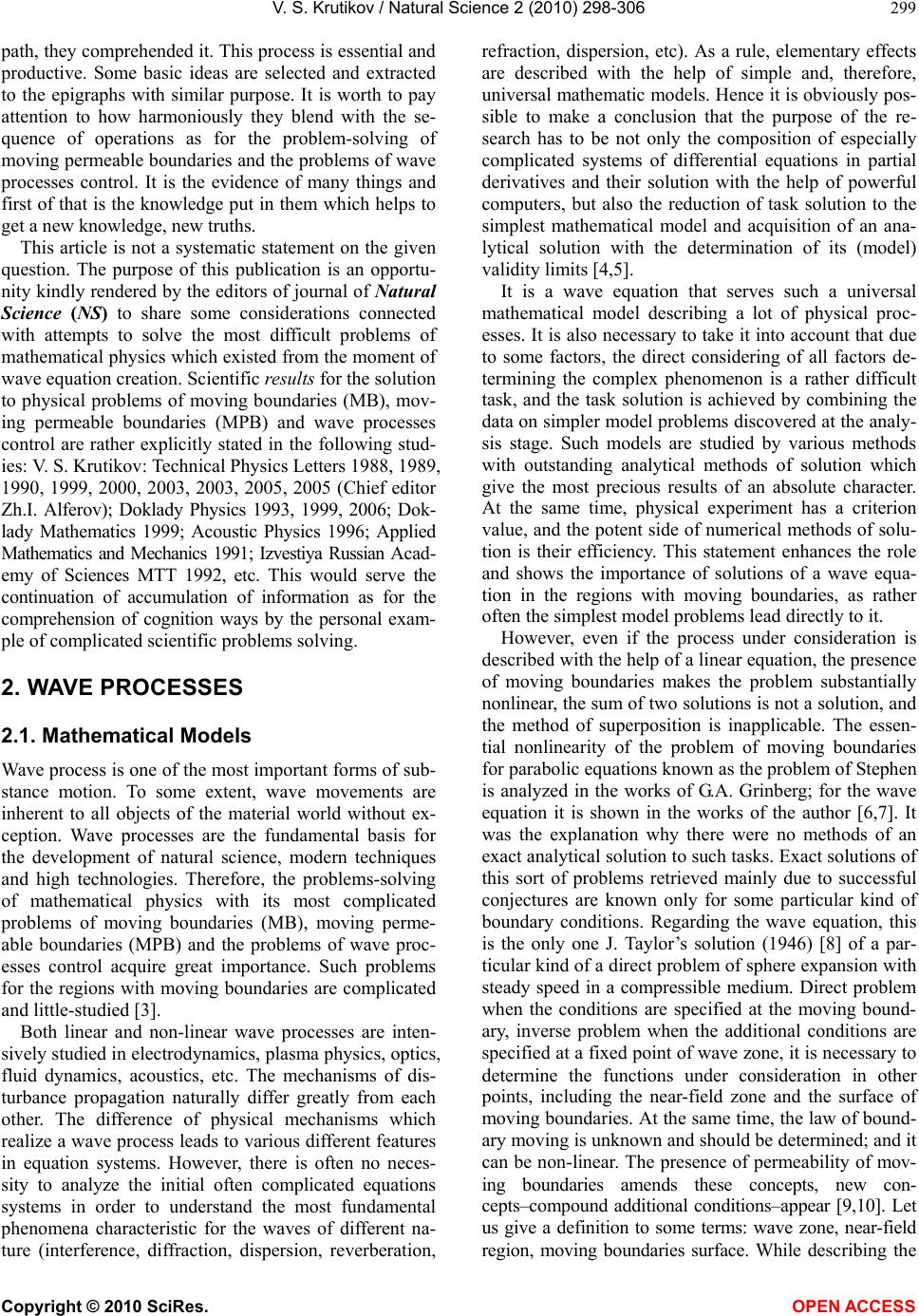 V. S. Krutikov / Natural Science 2 (2010) 298-306 Copyright © 2010 SciRes. OPEN ACCESS 299 path, they comprehended it. This process is essential and productive. Some basic ideas are selected and extracted to the epigraphs with similar purpose. It is worth to pay attention to how harmoniously they blend with the se- quence of operations as for the problem-solving of moving permeable boundaries and the problems of wave processes control. It is the evidence of many things and first of that is the knowledge put in them which helps to get a new knowledge, new truths. This article is not a systematic statement on the given question. The purpose of this publication is an opportu- nity kindly rendered by the editors of journal of Natural Science (NS) to share some considerations connected with attempts to solve the most difficult problems of mathematical physics which existed from the moment of wave equation creation. Scientific results for the solution to physical problems of moving boundaries (MB), mov- ing permeable boundaries (MPB) and wave processes control are rather explicitly stated in the following stud- ies: V. S. Krutikov: Technical Physics Letters 1988, 1989, 1990, 1999, 2000, 2003, 2003, 2005, 2005 (Chief editor Zh.I. Alferov); Doklady Physics 1993, 1999, 2006; Dok- lady Mathematics 1999; Acoustic Physics 1996; Applied Mathematics and Mechanics 1991; Izvestiya Russian Acad- emy of Sciences МТТ 1992, etc. This would serve the continuation of accumulation of information as for the comprehension of cognition ways by the personal exam- ple of complicated scientific problems solving. 2. WAVE PROCESSES 2.1. Mathematical Models Wave process is one of the most important forms of sub- stance motion. To some extent, wave movements are inherent to all objects of the material world without ex- ception. Wave processes are the fundamental basis for the development of natural science, modern techniques and high technologies. Therefore, the problems-solving of mathematical physics with its most complicated problems of moving boundaries (MB), moving perme- able boundaries (MPB) and the problems of wave proc- esses control acquire great importance. Such problems for the regions with moving boundaries are complicated and little-studied [3]. Both linear and non-linear wave processes are inten- sively studied in electrodynamics, plasma physics, optics, fluid dynamics, acoustics, etc. The mechanisms of dis- turbance propagation naturally differ greatly from each other. The difference of physical mechanisms which realize a wave process leads to various different features in equation systems. However, there is often no neces- sity to analyze the initial often complicated equations systems in order to understand the most fundamental phenomena characteristic for the waves of different na- ture (interference, diffraction, dispersion, reverberation, refraction, dispersion, etc). As a rule, elementary effects are described with the help of simple and, therefore, universal mathematic models. Hence it is obviously pos- sible to make a conclusion that the purpose of the re- search has to be not only the composition of especially complicated systems of differential equations in partial derivatives and their solution with the help of powerful computers, but also the reduction of task solution to the simplest mathematical model and acquisition of an ana- lytical solution with the determination of its (model) validity limits [4,5]. It is a wave equation that serves such a universal mathematical model describing a lot of physical proc- esses. It is also necessary to take it into account that due to some factors, the direct considering of all factors de- termining the complex phenomenon is a rather difficult task, and the task solution is achieved by combining the data on simpler model problems discovered at the analy- sis stage. Such models are studied by various methods with outstanding analytical methods of solution which give the most precious results of an absolute character. At the same time, physical experiment has a criterion value, and the potent side of numerical methods of solu- tion is their efficiency. This statement enhances the role and shows the importance of solutions of a wave equa- tion in the regions with moving boundaries, as rather often the simplest model problems lead directly to it. However, even if the process under consideration is described with the help of a linear equation, the presence of moving boundaries makes the problem substantially nonlinear, the sum of two solutions is not a solution, and the method of superposition is inapplicable. The essen- tial nonlinearity of the problem of moving boundaries for parabolic equations known as the problem of Stephen is analyzed in the works of G.A. Grinberg; for the wave equation it is shown in the works of the author [6,7]. It was the explanation why there were no methods of an exact analytical solution to such tasks. Exact solutions of this sort of problems retrieved mainly due to successful conjectures are known only for some particular kind of boundary conditions. Regarding the wave equation, this is the only one J. Taylor’s solution (1946) [8] of a par- ticular kind of a direct problem of sphere expansion with steady speed in a compressible medium. Direct problem when the conditions are specified at the moving bound- ary, inverse problem when the additional conditions are specified at a fixed point of wave zone, it is necessary to determine the functions under consideration in other points, including the near-field zone and the surface of moving boundaries. At the same time, the law of bound- ary moving is unknown and should be determined; and it can be non-linear. The presence of permeability of mov- ing boundaries amends thеsе concepts, new con- cepts–compound additional conditions–appear [9,10]. Let us give a definition to some terms: wave zone, near-field region, moving boundaries surface. While describing the 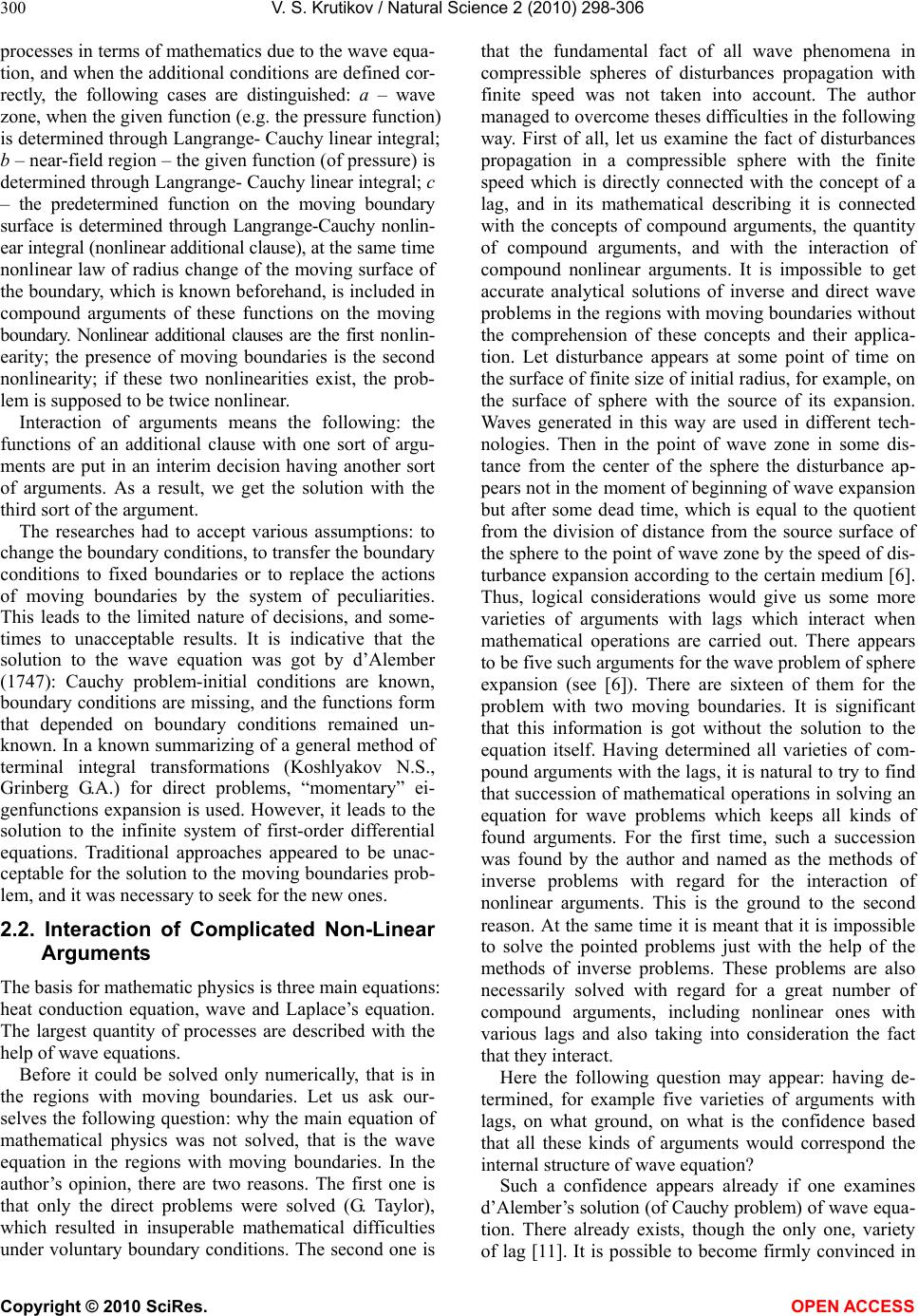 V. S. Krutikov / Natural Science 2 (2010) 298-306 Copyright © 2010 SciRes. OPEN ACCESS 300 processes in terms of mathematics due to the wave equa- tion, and when the additional conditions are defined cor- rectly, the following cases are distinguished: а – wave zone, when the given function (e.g. the pressure function) is determined through Langrangе- Cauchy linear integral; b – near-field region – the given function (of pressure) is determined through Langrangе- Cauchy linear integral; c – the predetermined function on the moving boundary surface is determined through Langrangе-Cauchy nonlin- ear integral (nonlinear additional clause), at the same time nonlinear law of radius change of the moving surface of the boundary, which is known beforehand, is included in compound arguments of these functions on the moving boundary. Nonlinear additional clauses are the first nonlin- earity; the presence of moving boundaries is the second nonlinearity; if these two nonlinearities exist, the prob- lem is supposed to be twice nonlinear. Interaction of arguments means the following: the functions of an additional clause with one sort of argu- ments are put in an interim decision having another sort of arguments. As a result, we get the solution with the third sort of the argument. The researches had to accept various assumptions: to change the boundary conditions, to transfer the boundary conditions to fixed boundaries or to replace the actions of moving boundaries by the system of peculiarities. This leads to the limited nature of decisions, and some- times to unacceptable results. It is indicative that the solution to the wave equation was got by d’Alember (1747): Cauchy problem-initial conditions are known, boundary conditions are missing, and the functions form that depended on boundary conditions remained un- known. In a known summarizing of a general method of terminal integral transformations (Koshlyakov N.S., Grinberg G.А.) for direct problems, “momentary” ei- genfunctions expansion is used. However, it leads to the solution to the infinite system of first-order differential equations. Traditional approaches appeared to be unac- ceptable for the solution to the moving boundaries prob- lem, and it was necessary to seek for the new ones. 2.2. Interaction of Complicated Non-Linear Arguments The basis for mathematic physics is three main equations: heat conduction equation, wave and Laplace’s equation. The largest quantity of processes are described with the help of wave equations. Before it could be solved only numerically, that is in the regions with moving boundaries. Let us ask our- selves the following question: why the main equation of mathematical physics was not solved, that is the wave equation in the regions with moving boundaries. In the author’s opinion, there are two reasons. The first one is that only the direct problems were solved (G. Taylor), which resulted in insuperable mathematical difficulties under voluntary boundary conditions. The second one is that the fundamental fact of all wave phenomena in compressible spheres of disturbances propagation with finite speed was not taken into account. The author managed to overcome theses difficulties in the following way. First of all, let us examine the fact of disturbances propagation in a compressible sphere with the finite speed which is directly connected with the concept of a lag, and in its mathematical describing it is connected with the concepts of compound arguments, the quantity of compound arguments, and with the interaction of compound nonlinear arguments. It is impossible to get accurate analytical solutions of inverse and direct wave problems in the regions with moving boundaries without the comprehension of these concepts and their applica- tion. Let disturbance appears at some point of time on the surface of finite size of initial radius, for example, on the surface of sphere with the source of its expansion. Waves generated in this way are used in different tech- nologies. Then in the point of wave zone in some dis- tance from the center of the sphere the disturbance ap- pears not in the moment of beginning of wave expansion but after some dead time, which is equal to the quotient from the division of distance from the source surface of the sphere to the point of wave zone by the speed of dis- turbance expansion according to the certain medium [6]. Thus, logical considerations would give us some more varieties of arguments with lags which interact when mathematical operations are carried out. There appears to be five such arguments for the wave problem of sphere expansion (see [6]). There are sixteen of them for the problem with two moving boundaries. It is significant that this information is got without the solution to the equation itself. Having determined all varieties of com- pound arguments with the lags, it is natural to try to find that succession of mathematical operations in solving an equation for wave problems which keeps all kinds of found arguments. For the first time, such a succession was found by the author and named as the methods of inverse problems with regard for the interaction of nonlinear arguments. This is the ground to the second reason. At the same time it is meant that it is impossible to solve the pointed problems just with the help of the methods of inverse problems. These problems are also necessarily solved with regard for a great number of compound arguments, including nonlinear ones with various lags and also taking into consideration the fact that they interact. Here the following question may appear: having de- termined, for example five varieties of arguments with lags, on what ground, on what is the confidence based that all these kinds of arguments would correspond the internal structure of wave equation? Such a confidence appears already if one examines d’Alember’s solution (of Cauchy problem) of wave equa- tion. There already exists, though the only one, variety of lag [11]. It is possible to become firmly convinced in 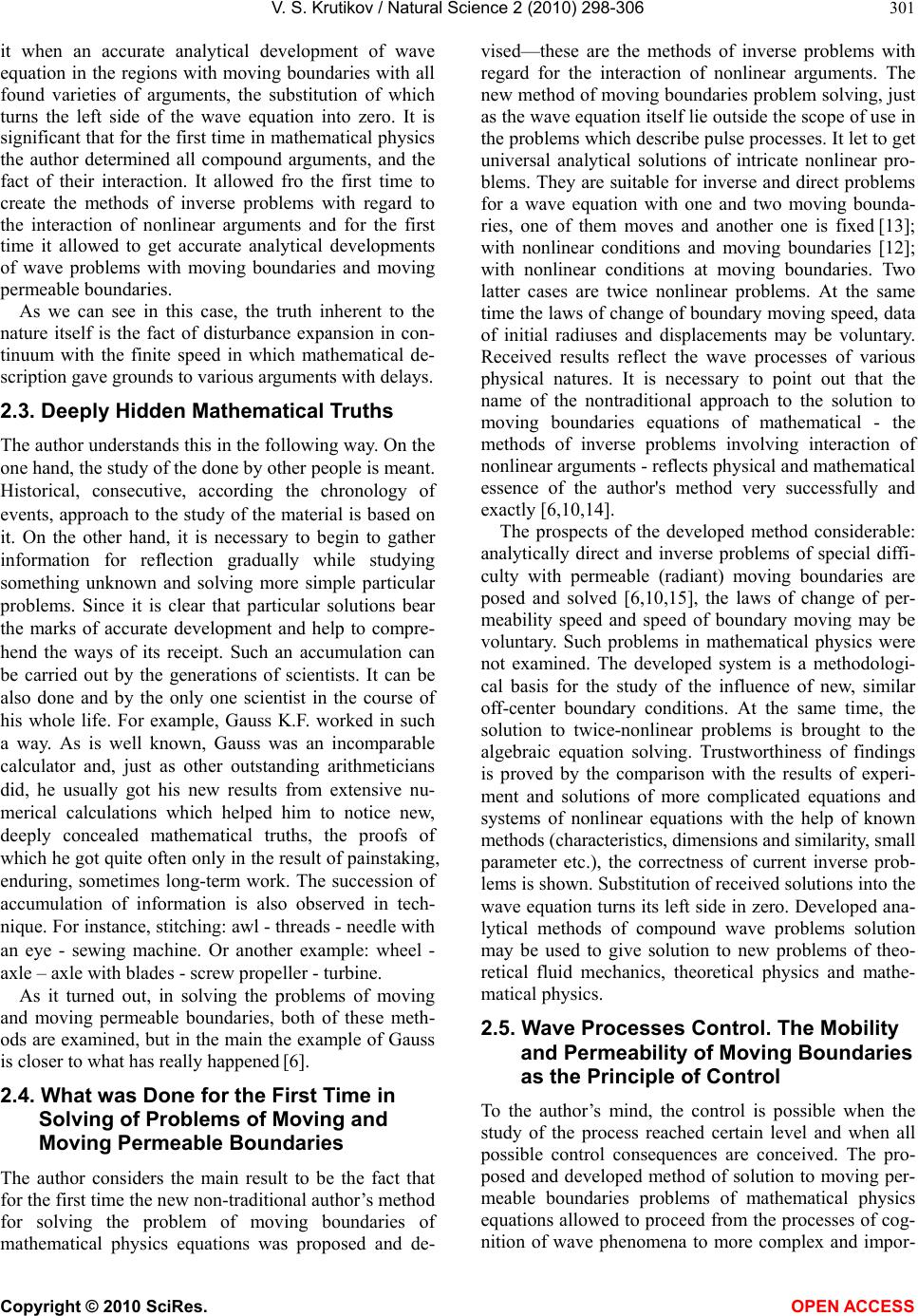 V. S. Krutikov / Natural Science 2 (2010) 298-306 Copyright © 2010 SciRes. OPEN ACCESS 301 it when an accurate analytical development of wave equation in the regions with moving boundaries with all found varieties of arguments, the substitution of which turns the left side of the wave equation into zero. It is significant that for the first time in mathematical physics the author determined all compound arguments, and the fact of their interaction. It allowed fro the first time to create the methods of inverse problems with regard to the interaction of nonlinear arguments and for the first time it allowed to get accurate analytical developments of wave problems with moving boundaries and moving permeable boundaries. As we can see in this case, the truth inherent to the nature itself is the fact of disturbance expansion in con- tinuum with the finite speed in which mathematical de- scription gave grounds to various arguments with delays. 2.3. Deeply Hidden Mathematical Truths The author understands this in the following way. On the one hand, the study of the done by other people is meant. Historical, consecutive, according the chronology of events, approach to the study of the material is based on it. On the other hand, it is necessary to begin to gather information for reflection gradually while studying something unknown and solving more simple particular problems. Since it is clear that particular solutions bear the marks of accurate development and help to compre- hend the ways of its receipt. Such an accumulation can be carried out by the generations of scientists. It can be also done and by the only one scientist in the course of his whole life. For example, Gauss K.F. worked in such a way. As is well known, Gauss was an incomparable calculator and, just as other outstanding arithmeticians did, he usually got his new results from extensive nu- merical calculations which helped him to notice new, deeply concealed mathematical truths, the proofs of which he got quite often only in the result of painstaking, enduring, sometimes long-term work. The succession of accumulation of information is also observed in tech- nique. For instance, stitching: awl - threads - needle with an eye - sewing machine. Or another example: wheel - axle – axle with blades - screw propeller - turbine. As it turned out, in solving the problems of moving and moving permeable boundaries, both of these meth- ods are examined, but in the main the example of Gauss is closer to what has really happened [6]. 2.4. What was Done for the First Time in Solving of Problems of Moving and Moving Permeable Boundaries The author considers the main result to be the fact that for the first time the new non-traditional author’s method for solving the problem of moving boundaries of mathematical physics equations was proposed and de- vised—these are the methods of inverse problems with regard for the interaction of nonlinear arguments. The new method of moving boundaries problem solving, just as the wave equation itself lie outside the scope of use in the problems which describe pulse processes. It let to get universal analytical solutions of intricate nonlinear pro- blems. They are suitable for inverse and direct problems for a wave equation with one and two moving bounda- ries, one of them moves and another one is fixed [13]; with nonlinear conditions and moving boundaries [12]; with nonlinear conditions at moving boundaries. Two latter cases are twice nonlinear problems. At the same time the laws of change of boundary moving speed, data of initial radiuses and displacements may be voluntary. Received results reflect the wave processes of various physical natures. It is necessary to point out that the name of the nontraditional approach to the solution to moving boundaries equations of mathematical - the methods of inverse problems involving interaction of nonlinear arguments - reflects physical and mathematical essence of the author's method very successfully and exactly [6,10,14]. The prospects of the developed method considerable: analytically direct and inverse problems of special diffi- culty with permeable (radiant) moving boundaries are posed and solved [6,10,15], the laws of change of per- meability speed and speed of boundary moving may be voluntary. Such problems in mathematical physics were not examined. The developed system is a methodologi- cal basis for the study of the influence of new, similar off-center boundary conditions. At the same time, the solution to twice-nonlinear problems is brought to the algebraic equation solving. Trustworthiness of findings is proved by the comparison with the results of experi- ment and solutions of more complicated equations and systems of nonlinear equations with the help of known methods (characteristics, dimensions and similarity, small parameter etc.), the correctness of current inverse prob- lems is shown. Substitution of received solutions into the wave equation turns its left side in zero. Developed ana- lytical methods of compound wave problems solution may be used to give solution to new problems of theo- retical fluid mechanics, theoretical physics and mathe- matical physics. 2.5. Wave Processes Control. The Mobility and Permeability of Moving Boundaries as the Principle of Control To the author’s mind, the control is possible when the study of the process reached certain level and when all possible control consequences are conceived. The pro- posed and developed method of solution to moving per- meable boundaries problems of mathematical physics equations allowed to proceed from the processes of cog- nition of wave phenomena to more complex and impor- 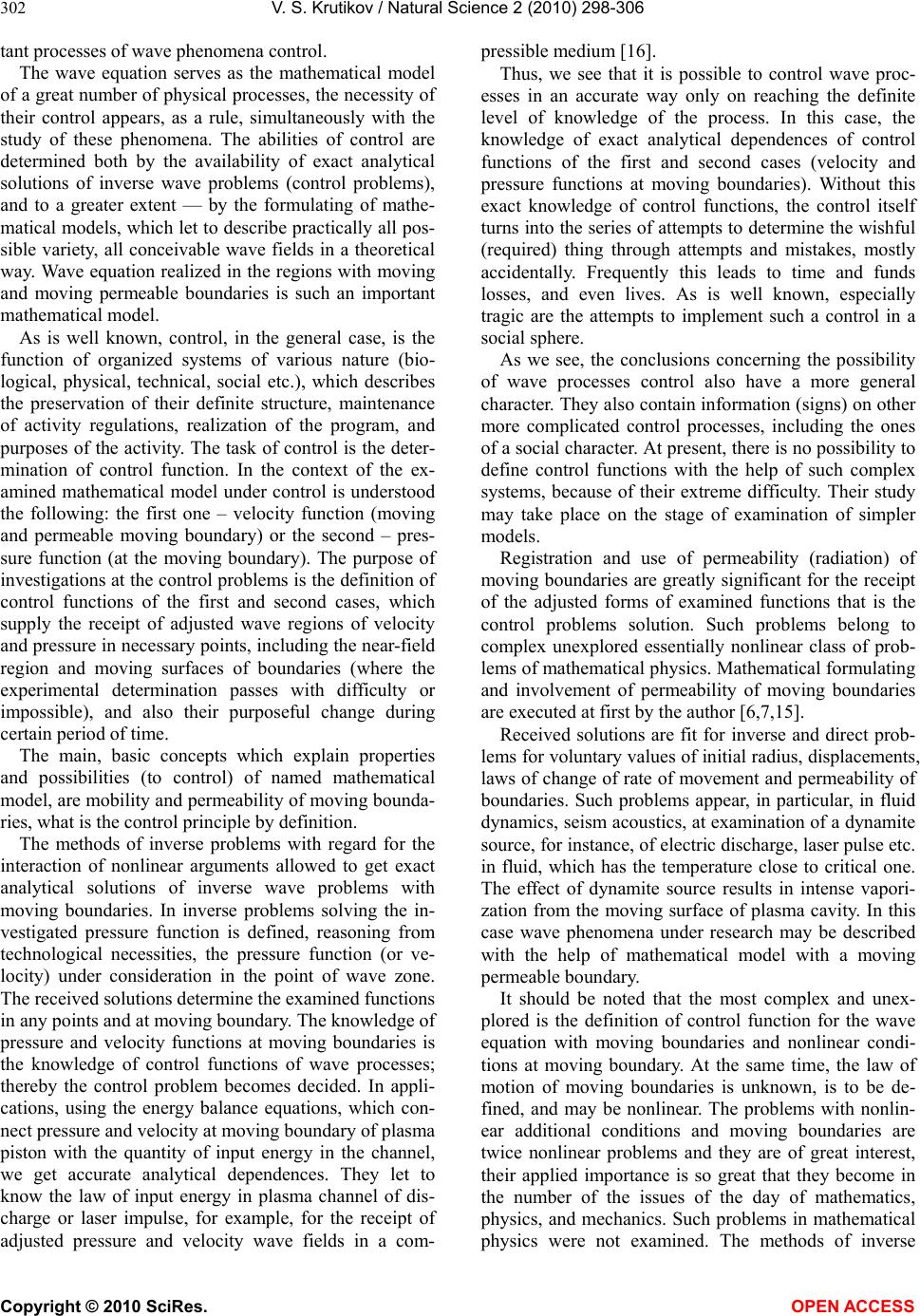 V. S. Krutikov / Natural Science 2 (2010) 298-306 Copyright © 2010 SciRes. OPEN ACCESS 302 tant processes of wave phenomena control. The wave equation serves as the mathematical model of a great number of physical processes, the necessity of their control appears, as a rule, simultaneously with the study of these phenomena. The abilities of control are determined both by the availability of exact analytical solutions of inverse wave problems (control problems), and to a greater extent — by the formulating of mathe- matical models, which let to describe practically all pos- sible variety, all conceivable wave fields in a theoretical way. Wave equation realized in the regions with moving and moving permeable boundaries is such an important mathematical model. As is well known, control, in the general case, is the function of organized systems of various nature (bio- logical, physical, technical, social etc.), which describes the preservation of their definite structure, maintenance of activity regulations, realization of the program, and purposes of the activity. The task of control is the deter- mination of control function. In the context of the ex- amined mathematical model under control is understood the following: the first one – velocity function (moving and permeable moving boundary) or the second – pres- sure function (at the moving boundary). The purpose of investigations at the control problems is the definition of control functions of the first and second cases, which supply the receipt of adjusted wave regions of velocity and pressure in necessary points, including the near-field region and moving surfaces of boundaries (where the experimental determination passes with difficulty or impossible), and also their purposeful change during certain period of time. The main, basic concepts which explain properties and possibilities (to control) of named mathematical model, are mobility and permeability of moving bounda- ries, what is the control principle by definition. The methods of inverse problems with regard for the interaction of nonlinear arguments allowed to get exact analytical solutions of inverse wave problems with moving boundaries. In inverse problems solving the in- vestigated pressure function is defined, reasoning from technological necessities, the pressure function (or ve- locity) under consideration in the point of wave zone. The received solutions determine the examined functions in any points and at moving boundary. The knowledge of pressure and velocity functions at moving boundaries is the knowledge of control functions of wave processes; thereby the control problem becomes decided. In appli- cations, using the energy balance equations, which con- nect pressure and velocity at moving boundary of plasma piston with the quantity of input energy in the channel, we get accurate analytical dependences. They let to know the law of input energy in plasma channel of dis- charge or laser impulse, for example, for the receipt of adjusted pressure and velocity wave fields in a com- pressible medium [16]. Thus, we see that it is possible to control wave proc- esses in an accurate way only on reaching the definite level of knowledge of the process. In this case, the knowledge of exact analytical dependences of control functions of the first and second cases (velocity and pressure functions at moving boundaries). Without this exact knowledge of control functions, the control itself turns into the series of attempts to determine the wishful (required) thing through attempts and mistakes, mostly accidentally. Frequently this leads to time and funds losses, and even lives. As is well known, especially tragic are the attempts to implement such a control in a social sphere. As we see, the conclusions concerning the possibility of wave processes control also have a more general character. They also contain information (signs) on other more complicated control processes, including the ones of a social character. At present, there is no possibility to define control functions with the help of such complex systems, because of their extreme difficulty. Their study may take place on the stage of examination of simpler models. Registration and use of permeability (radiation) of moving boundaries are greatly significant for the receipt of the adjusted forms of examined functions that is the control problems solution. Such problems belong to complex unexplored essentially nonlinear class of prob- lems of mathematical physics. Mathematical formulating and involvement of permeability of moving boundaries are executed at first by the author [6,7,15]. Received solutions are fit for inverse and direct prob- lems for voluntary values of initial radius, displacements, laws of change of rate of movement and permeability of boundaries. Such problems appear, in particular, in fluid dynamics, seism acoustics, at examination of a dynamite source, for instance, of electric discharge, laser pulse etc. in fluid, which has the temperature close to critical one. The effect of dynamite source results in intense vapori- zation from the moving surface of plasma cavity. In this case wave phenomena under research may be described with the help of mathematical model with a moving permeable boundary. It should be noted that the most complex and unex- plored is the definition of control function for the wave equation with moving boundaries and nonlinear condi- tions at moving boundary. At the same time, the law of motion of moving boundaries is unknown, is to be de- fined, and may be nonlinear. The problems with nonlin- ear additional conditions and moving boundaries are twice nonlinear problems and they are of great interest, their applied importance is so great that they become in the number of the issues of the day of mathematics, physics, and mechanics. Such problems in mathematical physics were not examined. The methods of inverse 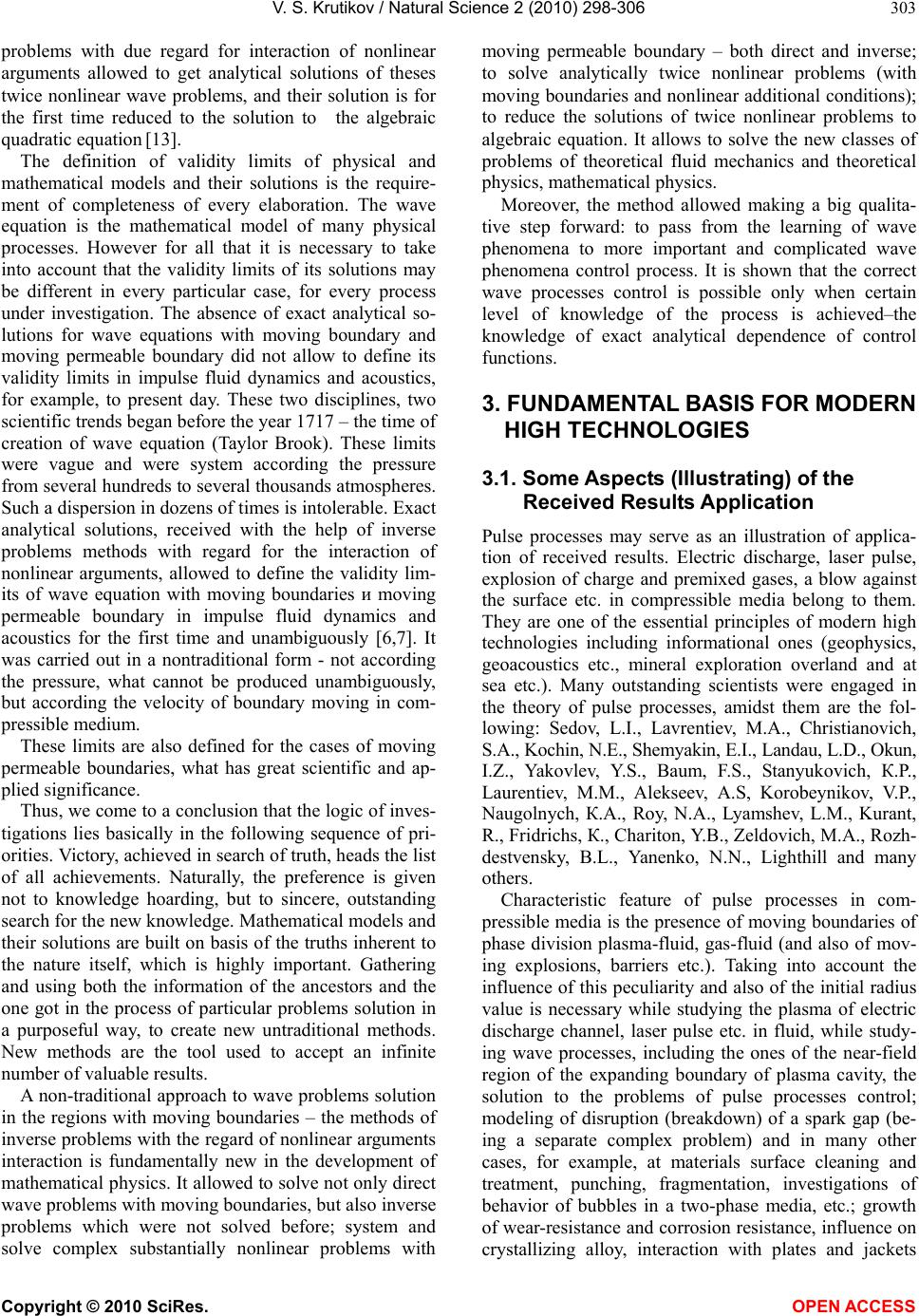 V. S. Krutikov / Natural Science 2 (2010) 298-306 Copyright © 2010 SciRes. OPEN ACCESS 303 problems with due regard for interaction of nonlinear arguments allowed to get analytical solutions of theses twice nonlinear wave problems, and their solution is for the first time reduced to the solution to the algebraic quadratic equation [13]. The definition of validity limits of physical and mathematical models and their solutions is the require- ment of completeness of every elaboration. The wave equation is the mathematical model of many physical processes. However for all that it is necessary to take into account that the validity limits of its solutions may be different in every particular case, for every process under investigation. The absence of exact analytical so- lutions for wave equations with moving boundary and moving permeable boundary did not allow to define its validity limits in impulse fluid dynamics and acoustics, for example, to present day. These two disciplines, two scientific trends began before the year 1717 – the time of creation of wave equation (Taylor Brook). These limits were vague and were system according the pressure from several hundreds to several thousands atmospheres. Such a dispersion in dozens of times is intolerable. Exact analytical solutions, received with the help of inverse problems methods with regard for the interaction of nonlinear arguments, allowed to define the validity lim- its of wave equation with moving boundaries и moving permeable boundary in impulse fluid dynamics and acoustics for the first time and unambiguously [6,7]. It was carried out in a nontraditional form - not according the pressure, what cannot be produced unambiguously, but according the velocity of boundary moving in com- pressible medium. These limits are also defined for the cases of moving permeable boundaries, what has great scientific and ap- plied significance. Thus, we come to a conclusion that the logic of inves- tigations lies basically in the following sequence of pri- orities. Victory, achieved in search of truth, heads the list of all achievements. Naturally, the preference is given not to knowledge hoarding, but to sincere, outstanding search for the new knowledge. Mathematical models and their solutions are built on basis of the truths inherent to the nature itself, which is highly important. Gathering and using both the information of the ancestors and the one got in the process of particular problems solution in a purposeful way, to create new untraditional methods. New methods are the tool used to accept an infinite number of valuable results. A non-traditional approach to wave problems solution in the regions with moving boundaries – the methods of inverse problems with the regard of nonlinear arguments interaction is fundamentally new in the development of mathematical physics. It allowed to solve not only direct wave problems with moving boundaries, but also inverse problems which were not solved before; system and solve complex substantially nonlinear problems with moving permeable boundary – both direct and inverse; to solve analytically twice nonlinear problems (with moving boundaries and nonlinear additional conditions); to reduce the solutions of twice nonlinear problems to algebraic equation. It allows to solve the new classes of problems of theoretical fluid mechanics and theoretical physics, mathematical physics. Moreover, the method allowed making a big qualita- tive step forward: to pass from the learning of wave phenomena to more important and complicated wave phenomena control process. It is shown that the correct wave processes control is possible only when certain level of knowledge of the process is achieved–the knowledge of exact analytical dependence of control functions. 3. FUNDAMENTAL BASIS FOR MODERN HIGH TECHNOLOGIES 3.1. Some Aspects (Illustrating) of the Received Results Application Pulse processes may serve as an illustration of applica- tion of received results. Electric discharge, laser pulse, explosion of charge and premixed gases, a blow against the surface etc. in compressible media belong to them. They are one of the essential principles of modern high technologies including informational ones (geophysics, geoacoustics etc., mineral exploration overland and at sea etc.). Many outstanding scientists were engaged in the theory of pulse processes, amidst them are the fol- lowing: Sedov, L.I., Lavrentiev, М.А., Christianovich, S.А., Kochin, N.Е., Shemyakin, Е.I., Landau, L.D., Okun, I.Z., Yakovlev, Y.S., Baum, F.S., Stanyukovich, К.P., Laurentiev, М.М., Alekseev, А.S, Korobeynikov, V.P., Naugolnych, К.А., Roy, N.А., Lyamshev, L.М., Kurant, R., Fridrichs, К., Chariton, Y.B., Zeldovich, M.A., Rozh- destvensky, B.L., Yanenko, N.N., Lighthill and many others. Characteristic feature of pulse processes in com- pressible media is the presence of moving boundaries of phase division plasma-fluid, gas-fluid (and also of mov- ing explosions, barriers etc.). Taking into account the influence of this peculiarity and also of the initial radius value is necessary while studying the plasma of electric discharge channel, laser pulse etc. in fluid, while study- ing wave processes, including the ones of the near-field region of the expanding boundary of plasma cavity, the solution to the problems of pulse processes control; modeling of disruption (breakdown) of a spark gap (be- ing a separate complex problem) and in many other cases, for example, at materials surface cleaning and treatment, punching, fragmentation, investigations of behavior of bubbles in a two-phase media, etc.; growth of wear-resistance and corrosion resistance, influence on crystallizing alloy, interaction with plates and jackets 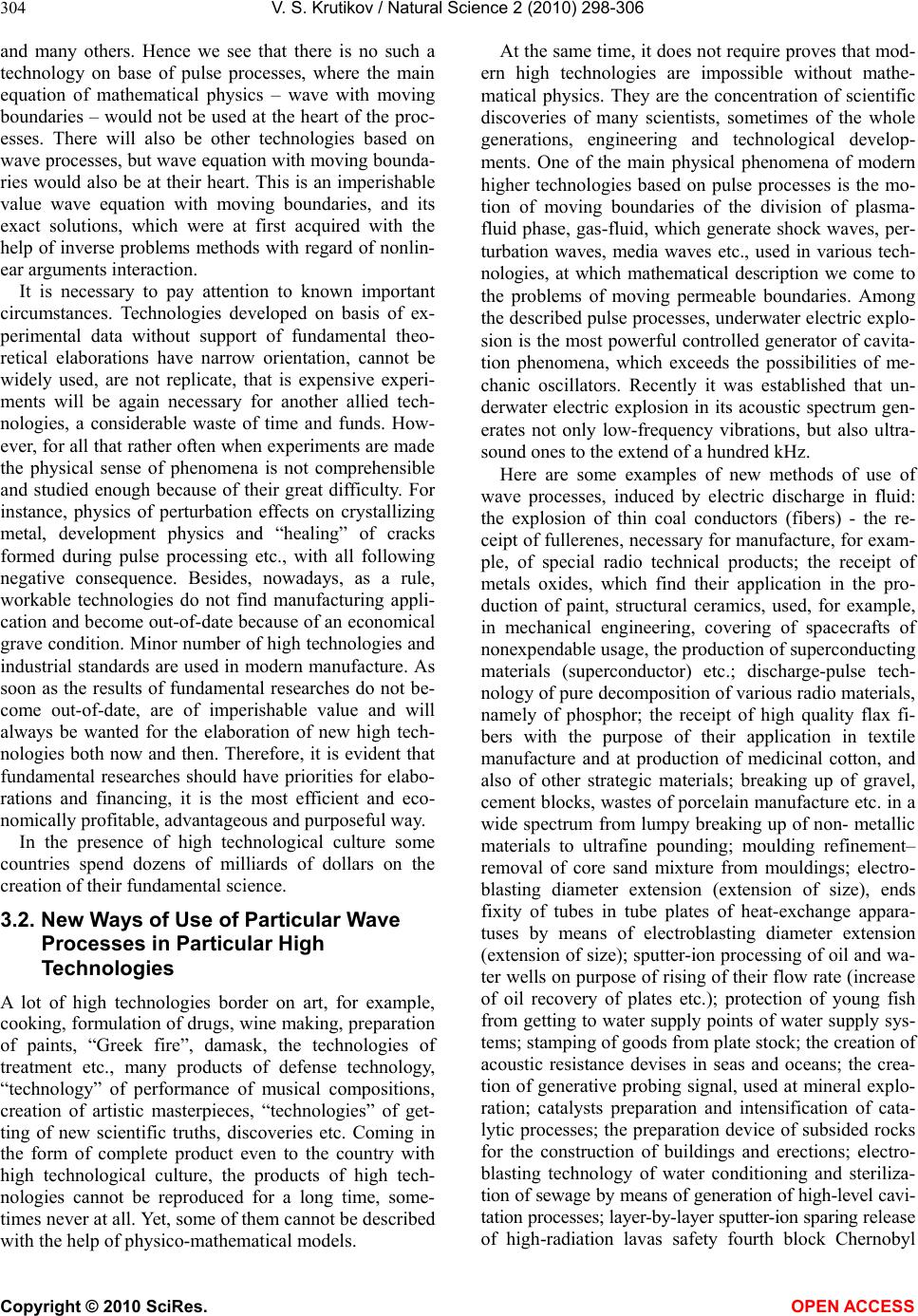 V. S. Krutikov / Natural Science 2 (2010) 298-306 Copyright © 2010 SciRes. OPEN ACCESS 304 and many others. Hence we see that there is no such a technology on base of pulse processes, where the main equation of mathematical physics – wave with moving boundaries – would not be used at the heart of the proc- esses. There will also be other technologies based on wave processes, but wave equation with moving bounda- ries would also be at their heart. This is an imperishable value wave equation with moving boundaries, and its exact solutions, which were at first acquired with the help of inverse problems methods with regard of nonlin- ear arguments interaction. It is necessary to pay attention to known important circumstances. Technologies developed on basis of ex- perimental data without support of fundamental theo- retical elaborations have narrow orientation, cannot be widely used, are not replicate, that is expensive experi- ments will be again necessary for another allied tech- nologies, a considerable waste of time and funds. How- ever, for all that rather often when experiments are made the physical sense of phenomena is not comprehensible and studied enough because of their great difficulty. For instance, physics of perturbation effects on crystallizing metal, development physics and “healing” of cracks formed during pulse processing etc., with all following negative consequence. Besides, nowadays, as a rule, workable technologies do not find manufacturing appli- cation and become out-of-date because of an economical grave condition. Minor number of high technologies and industrial standards are used in modern manufacture. As soon as the results of fundamental researches do not be- come out-of-date, are of imperishable value and will always be wanted for the elaboration of new high tech- nologies both now and then. Therefore, it is evident that fundamental researches should have priorities for elabo- rations and financing, it is the most efficient and eco- nomically profitable, advantageous and purposeful way. In the presence of high technological culture some countries spend dozens of milliards of dollars on the creation of their fundamental science. 3.2. New Ways of Use of Particular Wave Processes in Particular High Technologies A lot of high technologies border on art, for example, cooking, formulation of drugs, wine making, preparation of paints, “Greek fire”, damask, the technologies of treatment etc., many products of defense technology, “technology” of performance of musical compositions, creation of artistic masterpieces, “technologies” of get- ting of new scientific truths, discoveries etc. Coming in the form of complete product even to the country with high technological culture, the products of high tech- nologies cannot be reproduced for a long time, some- times never at all. Yet, some of them cannot be described with the help of physico-mathematical models. At the same time, it does not require proves that mod- ern high technologies are impossible without mathe- matical physics. They are the concentration of scientific discoveries of many scientists, sometimes of the whole generations, engineering and technological develop- ments. One of the main physical phenomena of modern higher technologies based on pulse processes is the mo- tion of moving boundaries of the division of plasma- fluid phase, gas-fluid, which generate shock waves, per- turbation waves, media waves etc., used in various tech- nologies, at which mathematical description we come to the problems of moving permeable boundaries. Among the described pulse processes, underwater electric explo- sion is the most powerful controlled generator of cavita- tion phenomena, which exceeds the possibilities of me- chanic oscillators. Recently it was established that un- derwater electric explosion in its acoustic spectrum gen- erates not only low-frequency vibrations, but also ultra- sound ones to the extend of a hundred kHz. Here are some examples of new methods of use of wave processes, induced by electric discharge in fluid: the explosion of thin coal conductors (fibers) - the re- ceipt of fullerenes, necessary for manufacture, for exam- ple, of special radio technical products; the receipt of metals oxides, which find their application in the pro- duction of paint, structural ceramics, used, for example, in mechanical engineering, covering of spacecrafts of nonexpendable usage, the production of superconducting materials (superconductor) etc.; discharge-pulse tech- nology of pure decomposition of various radio materials, namely of phosphor; the receipt of high quality flax fi- bers with the purpose of their application in textile manufacture and at production of medicinal cotton, and also of other strategic materials; breaking up of gravel, cement blocks, wastes of porcelain manufacture etc. in a wide spectrum from lumpy breaking up of non- metallic materials to ultrafine pounding; moulding refinement– removal of core sand mixture from mouldings; electro- blasting diameter extension (extension of size), ends fixity of tubes in tube plates of heat-exchange appara- tuses by means of electroblasting diameter extension (extension of size); sputter-ion processing of oil and wa- ter wells on purpose of rising of their flow rate (increase of oil recovery of plates etc.); protection of young fish from getting to water supply points of water supply sys- tems; stamping of goods from plate stock; the creation of acoustic resistance devises in seas and oceans; the crea- tion of generative probing signal, used at mineral explo- ration; catalysts preparation and intensification of cata- lytic processes; the preparation device of subsided rocks for the construction of buildings and erections; electro- blasting technology of water conditioning and steriliza- tion of sewage by means of generation of high-level cavi- tation processes; layer-by-layer sputter-ion sparing release of high-radiation lavas safety fourth block Chernobyl 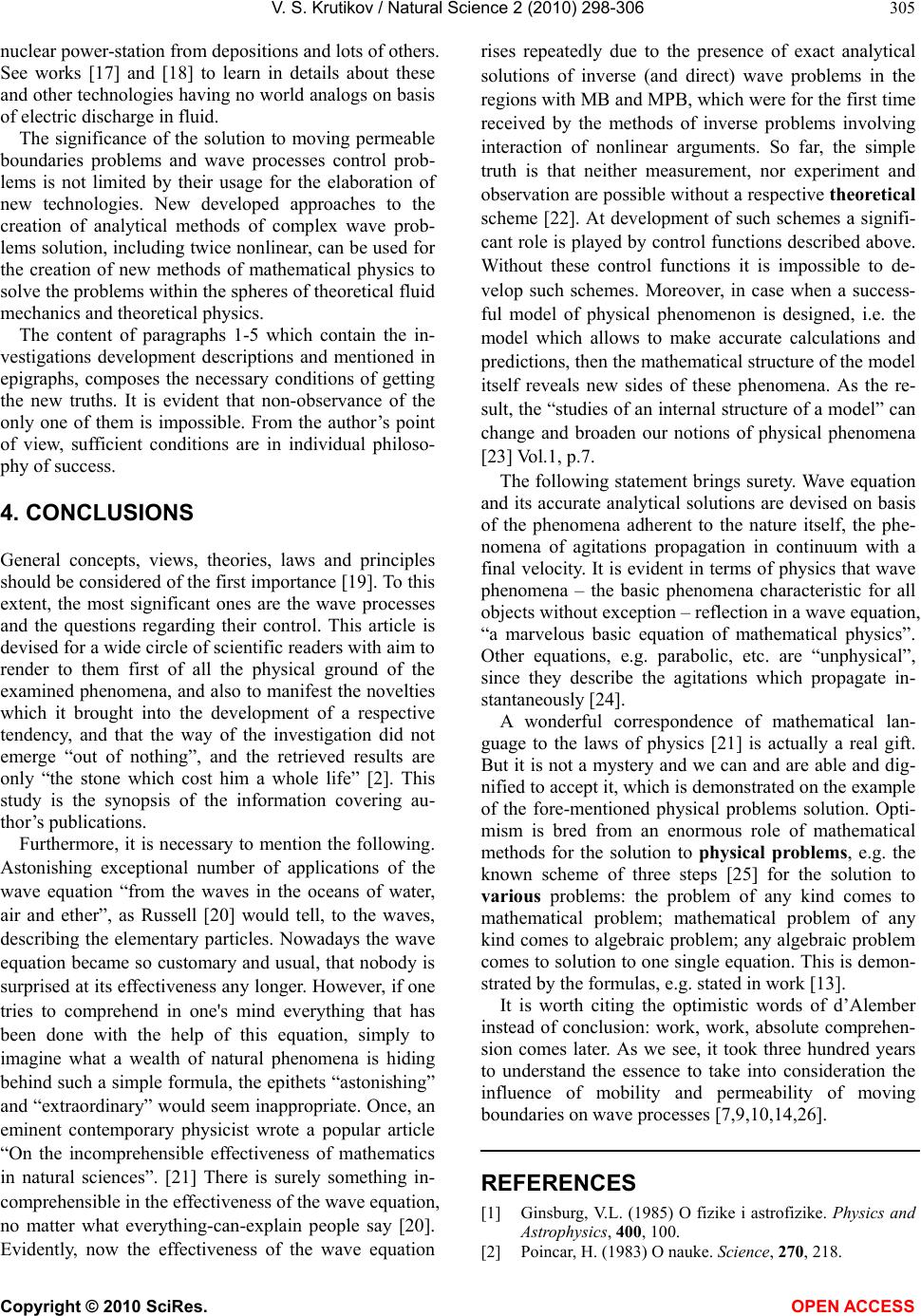 V. S. Krutikov / Natural Science 2 (2010) 298-306 Copyright © 2010 SciRes. OPEN ACCESS 305 nuclear power-station from depositions and lots of others. See works [17] and [18] to learn in details about these and other technologies having no world analogs on basis of electric discharge in fluid. The significance of the solution to moving permeable boundaries problems and wave processes control prob- lems is not limited by their usage for the elaboration of new technologies. New developed approaches to the creation of analytical methods of complex wave prob- lems solution, including twice nonlinear, can be used for the creation of new methods of mathematical physics to solve the problems within the spheres of theoretical fluid mechanics and theoretical physics. The content of paragraphs 1-5 which contain the in- vestigations development descriptions and mentioned in epigraphs, composes the necessary conditions of getting the new truths. It is evident that non-observance of the only one of them is impossible. From the author’s point of view, sufficient conditions are in individual philoso- phy of success. 4. CONCLUSIONS General concepts, views, theories, laws and principles should be considered of the first importance [19]. To this extent, the most significant ones are the wave processes and the questions regarding their control. This article is devised for a wide circle of scientific readers with aim to render to them first of all the physical ground of the examined phenomena, and also to manifest the novelties which it brought into the development of a respective tendency, and that the way of the investigation did not emerge “out of nothing”, and the retrieved results are only “the stone which cost him a whole life” [2]. This study is the synopsis of the information covering au- thor’s publications. Furthermore, it is necessary to mention the following. Astonishing exceptional number of applications of the wave equation “from the waves in the oceans of water, air and ether”, as Russell [20] would tell, to the waves, describing the elementary particles. Nowadays the wave equation became so customary and usual, that nobody is surprised at its effectiveness any longer. However, if one tries to comprehend in one's mind everything that has been done with the help of this equation, simply to imagine what a wealth of natural phenomena is hiding behind such a simple formula, the epithets “astonishing” and “extraordinary” would seem inappropriate. Once, an eminent contemporary physicist wrote a popular article “On the incomprehensible effectiveness of mathematics in natural sciences”. [21] There is surely something in- comprehensible in the effectiveness of the wave equation, no matter what everything-can-explain people say [20]. Evidently, now the effectiveness of the wave equation rises repeatedly due to the presence of exact analytical solutions of inverse (and direct) wave problems in the regions with MB and MPB, which were for the first time received by the methods of inverse problems involving interaction of nonlinear arguments. So far, the simple truth is that neither measurement, nor experiment and observation are possible without a respective theoretical scheme [22]. At development of such schemes a signifi- cant role is played by control functions described above. Without these control functions it is impossible to de- velop such schemes. Moreover, in case when a success- ful model of physical phenomenon is designed, i.e. the model which allows to make accurate calculations and predictions, then the mathematical structure of the model itself reveals new sides of these phenomena. As the re- sult, the “studies of an internal structure of a model” can change and broaden our notions of physical phenomena [23] Vol.1, p.7. The following statement brings surety. Wave equation and its accurate analytical solutions are devised on basis of the phenomena adherent to the nature itself, the phe- nomena of agitations propagation in continuum with a final velocity. It is evident in terms of physics that wave phenomena – the basic phenomena characteristic for all objects without exception – reflection in a wave equation, “a marvelous basic equation of mathematical physics”. Other equations, e.g. parabolic, etc. are “unphysical”, since they describe the agitations which propagate in- stantaneously [24]. A wonderful correspondence of mathematical lan- guage to the laws of physics [21] is actually a real gift. But it is not a mystery and we can and are able and dig- nified to accept it, which is demonstrated on the example of the fore-mentioned physical problems solution. Opti- mism is bred from an enormous role of mathematical methods for the solution to physical problems, e.g. the known scheme of three steps [25] for the solution to various problems: the problem of any kind comes to mathematical problem; mathematical problem of any kind comes to algebraic problem; any algebraic problem comes to solution to one single equation. This is demon- strated by the formulas, e.g. stated in work [13]. It is worth citing the optimistic words of d’Alember instead of conclusion: work, work, absolute comprehen- sion comes later. As we see, it took three hundred years to understand the essence to take into consideration the influence of mobility and permeability of moving boundaries on wave processes [7,9,10,14,26]. REFERENCES [1] Ginsburg, V.L. (1985) O fizike i astrofizike. Physics and Astrophysics, 400, 100. [2] Poincar, H. (1983) O nauke. Science, 270, 218. 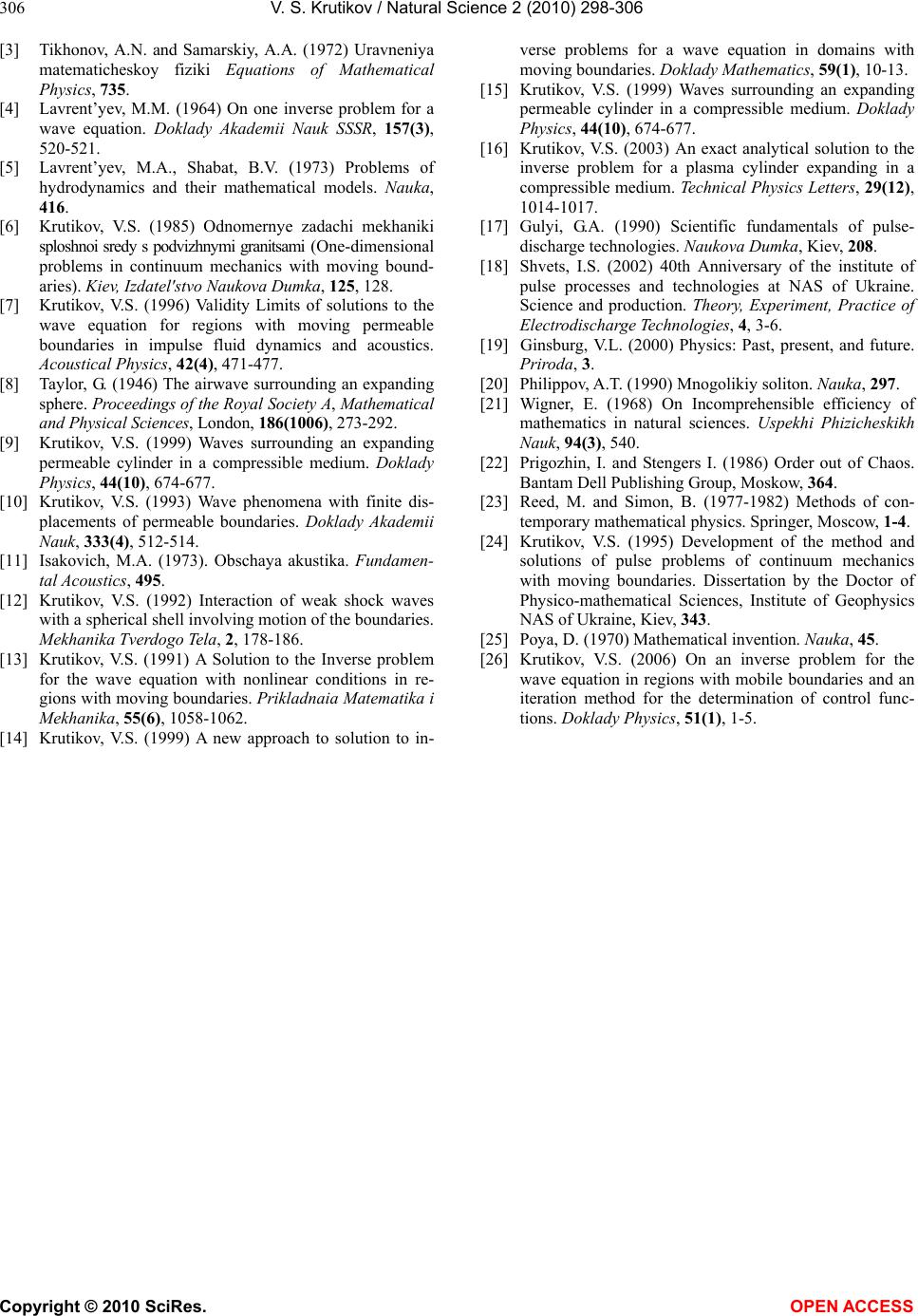 V. S. Krutikov / Natural Science 2 (2010) 298-306 Copyright © 2010 SciRes. OPEN ACCESS 306 [3] Tikhonov, A.N. and Samarskiy, А.А. (1972) Uravneniya matematicheskoy fiziki Equations of Mathematical Physics, 735. [4] Lavrent’yev, M.M. (1964) On one inverse problem for a wave equation. Doklady Akademii Nauk SSSR, 157(3), 520-521. [5] Lavrent’yev, M.А., Shabat, B.V. (1973) Problems of hydrodynamics and their mathematical models. Nauka, 416. [6] Krutikov, V.S. (1985) Odnomernye zadachi mekhaniki sploshnoi sredy s podvizhnymi granitsami (One-dimensional problems in continuum mechanics with moving bound- aries). Kiev, Izdatel'stvo Naukova Dumka, 125, 128. [7] Krutikov, V.S. (1996) Validity Limits of solutions to the wave equation for regions with moving permeable boundaries in impulse fluid dynamics and acoustics. Acoustical Physics, 42(4), 471-477. [8] Taylor, G. (1946) The airwave surrounding an expanding sphere. Proceedings of the Royal Society A, Mathematical and Physical Sciences, London, 186(1006), 273-292. [9] Krutikov, V.S. (1999) Waves surrounding an expanding permeable cylinder in a compressible medium. Doklady Physics, 44(10), 674-677. [10] Krutikov, V.S. (1993) Wave phenomena with finite dis- placements of permeable boundaries. Doklady Akademii Nauk, 333(4), 512-514. [11] Isakovich, M.A. (1973). Obschaya akustika. Fundamen- tal Acoustics, 495. [12] Krutikov, V.S. (1992) Interaction of weak shock waves with a spherical shell involving motion of the boundaries. Mekhanika Tverdogo Tela, 2, 178-186. [13] Krutikov, V.S. (1991) A Solution to the Inverse problem for the wave equation with nonlinear conditions in re- gions with moving boundaries. Prikladnaia Matematika i Mekhanika, 55(6), 1058-1062. [14] Krutikov, V.S. (1999) A new approach to solution to in- verse problems for a wave equation in domains with moving boundaries. Doklady Mathematics, 59(1), 10-13. [15] Krutikov, V.S. (1999) Waves surrounding an expanding permeable cylinder in a compressible medium. Doklady Physics, 44(10), 674-677. [16] Krutikov, V.S. (2003) An exact analytical solution to the inverse problem for a plasma cylinder expanding in a compressible medium. Technical Physics Letters, 29(12), 1014-1017. [17] Gulyi, G.A. (1990) Scientific fundamentals of pulse- discharge technologies. Naukova Dumka, Kiev, 208. [18] Shvets, I.S. (2002) 40th Anniversary of the institute of pulse processes and technologies at NAS of Ukraine. Science and production. Theory, Experiment, Practice of Electrodischarge Technologies, 4, 3-6. [19] Ginsburg, V.L. (2000) Physics: Past, present, and future. Priroda, 3. [20] Philippov, A.T. (1990) Mnogolikiy soliton. Nauka, 297. [21] Wigner, E. (1968) On Incomprehensible efficiency of mathematics in natural sciences. Uspekhi Phizicheskikh Nauk, 94(3), 540. [22] Prigozhin, I. and Stengers I. (1986) Order out of Chaos. Bantam Dell Publishing Group, Moskow, 364. [23] Reed, M. and Simon, B. (1977-1982) Methods of con- temporary mathematical physics. Springer, Moscow, 1-4. [24] Krutikov, V.S. (1995) Development of the method and solutions of pulse problems of continuum mechanics with moving boundaries. Dissertation by the Doctor of Physico-mathematical Sciences, Institute of Geophysics NAS of Ukraine, Kiev, 343. [25] Poya, D. (1970) Mathematical invention. Nauka, 45. [26] Krutikov, V.S. (2006) On an inverse problem for the wave equation in regions with mobile boundaries and an iteration method for the determination of control func- tions. Doklady Physics, 51(1), 1-5. |

